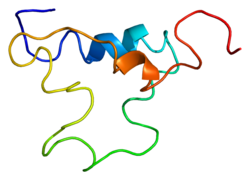Insulin-like growth factor 1
From Wikipedia, the free encyclopedia
Insulin-like growth factor 1 (IGF-1), also called somatomedin C, is a protein that in humans is encoded by the IGF1 gene.[1][2] IGF-1 has also been referred to as a "sulfation factor"[3] and its effects were termed "nonsuppressible insulin-like activity" (NSILA) in the 1970s.
IGF-1 is a hormone similar in molecular structure to insulin. It plays an important role in childhood growth and continues to have anabolic effects in adults. A synthetic analog of IGF-1, mecasermin is used for the treatment of growth failure.[4]
IGF-1 consists of 70 amino acids in a single chain with three intramolecular disulfide bridges. IGF-1 has a molecular weight of 7649 daltons.
Contents
- 1 Synthesis and circulation
- 2 Mechanism of action
- 3 Receptors
- 4 Related growth factors
- 5 Contribution to aging
- 6 Factors influencing the levels in the circulation
- 7 Neuropathy
- 8 Dwarfism
- 9 Cancer and IGF-I
- 10 Use as a diagnostic test
- 11 As a therapeutic agent
- 12 Interactions
- 13 References
- 14 Further reading
- 15 External links
| Insulin-like growth factor 1 (somatomedin C) | |||||||||||
|---|---|---|---|---|---|---|---|---|---|---|---|
 PDB rendering based on 1bqt. | |||||||||||
| |||||||||||
| Identifiers | |||||||||||
| Symbols | IGF1; IGF-I; IGF1A; IGFI | ||||||||||
| External IDs | OMIM: 147440 MGI: 96432 HomoloGene: 515 GeneCards: IGF1 Gene | ||||||||||
| |||||||||||
| RNA expression pattern | |||||||||||
 | |||||||||||
 | |||||||||||
 | |||||||||||
| More reference expression data | |||||||||||
| Orthologs | |||||||||||
| Species | Human | Mouse | |||||||||
| Entrez | 3479 | 16000 | |||||||||
| Ensembl | ENSG00000017427 | ENSMUSG00000020053 | |||||||||
| UniProt | P05019 | P05017 | |||||||||
| RefSeq (mRNA) | NM_000618.3 | NM_001111274.1 | |||||||||
| RefSeq (protein) | NP_000609.1 | NP_001104744.1 | |||||||||
| Location (UCSC) | Chr 12: 102.79 – 102.87 Mb | Chr 10: 87.32 – 87.4 Mb | |||||||||
| PubMed search | [1] | [2] | |||||||||